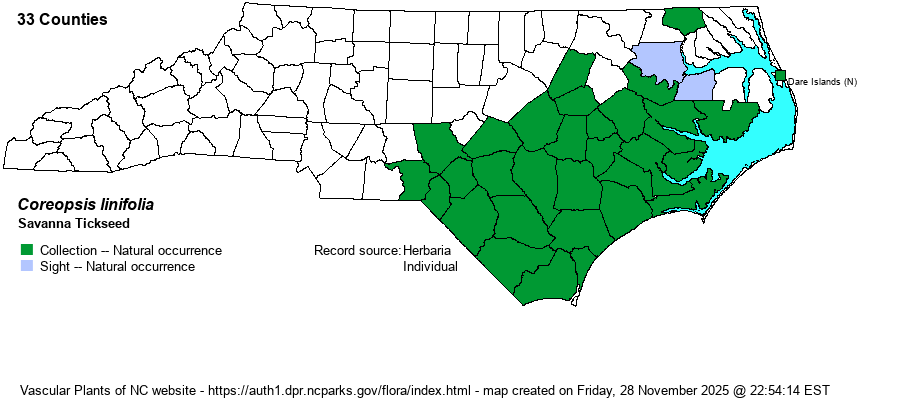| Section 6 » Order Asterales » Family Asteraceae |
Show/Hide Synonym
| taxonName | relationship | relatedTaxonName | relatedTaxonRefText | relComments |
|---|
|
|
|
|
|
|
|
| Coreopsis linifolia | = | Coreopsis angustifolia | Radford, Ahles, and Bell (1968) | misapplied | | Coreopsis linifolia | = | Coreopsis angustifolia | | misapplied | | Coreopsis linifolia | = | Coreopsis gladiata var. linifolia | Gleason and Cronquist (1991) | | | Coreopsis linifolia | = | Coreopsis gladiata var. linifolia | Gleason (1952) | | | Coreopsis linifolia | = | Coreopsis gladiata var. linifolia | Vascular Flora of the Southeastern States (Cronquist 1980, Isely 1990) | | | Coreopsis linifolia | > | Coreopsis oniscicarpa var. oniscicarpa | Fernald (1950) | | | Coreopsis linifolia | > | Coreopsis oniscicarpa var. simulans | Fernald (1950) | | | Coreopsis linifolia | < | Coreopsis gladiata | Flora of North America (1993b, 1997, 2000, 2002a, 2002b, 2003a, 2004b, 2005, 2006a, 2006b, 2006c, 2007a, 2009, 2010) | | | Source: Weakley's Flora |
|
| Author | Nuttall | |
| Distribution | Coastal Plain and Sandhills; rare on the Outer Banks (Roanoke Island). This species was formerly named as C. angustifolia in RAB (1968).
Coastal Plain, southeastern VA to northern FL and eastern TX. | |
| Abundance | Common in the Longleaf Pine (Pinus palustris) belt in the eastern Sandhills (Fort Bragg), the lower Coastal Plain, and in southern coastal counties, but uncommon to infrequent elsewhere. | |
| Habitat | Moist to wet Longleaf Pine--Wiregrass savannas and flatwoods, pitcher-plant seepages, pocosin ecotones, blackwater streamhead ecotones. | |
| Phenology | Flowering and fruiting July-October. | |
| Identification | This species is notable for its narrow leaves, especially the basal ones and those of non-flowering, young plants, which are thick-textured, about 10 mm wide (or a bit wider) and several inches long, tapering to long stalks. Up the stem, leaves rapidly lose the stalks and blades eventually become short and skinny. The inflorescence consists of few to several branches, terminated by single heads; the rays yellow and toothed, the disks brown. Basal and lower leaves are always narrower than those of C. gladiata, and it begins flowering much earlier. This is the common savanna/flatwoods Coreopsis blooming in late summer and fall; C. falcata is the common one blooming in late spring or early summer. | |
| Taxonomic Comments | Until Smith (1976) straightened things out, authors treated this species as part of C. gladiata. Even after that monograph, some authors continued to lump it (and other species) into the latter (e.g., FNA in 2006) -- most unfortunate. See Sorrie et al. (2013) for discussion of this group of tickseeds. There are 2 "chromosome races" within Savanna Tickseed, one Atlantic and one Gulf; their taxonomy is unsettled.
For excellent drawings of all species (except those recently described) and range maps (although now out-of-date), see the monograph by Smith (1976). | |
| Other Common Name(s) | Texas Tickseed | |
| State Rank | S4 | |
| Global Rank | G4Q | |
| State Status | | |
| US Status | | |
| USACE-agcp | FACW link |
| USACE-emp | FACW link |

